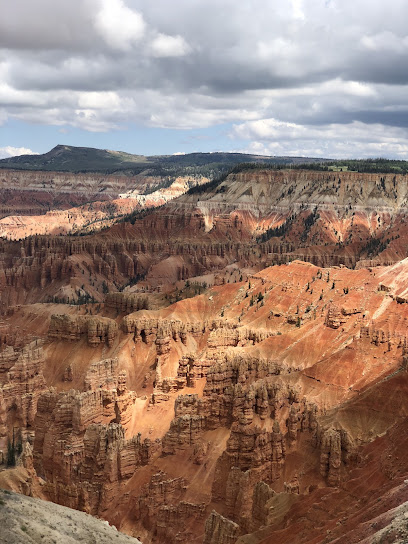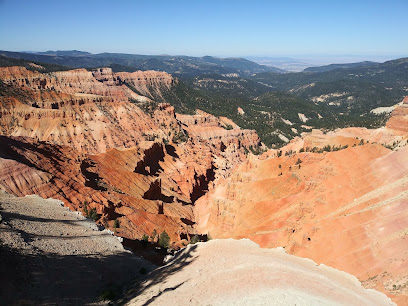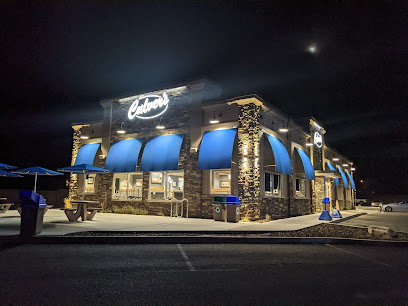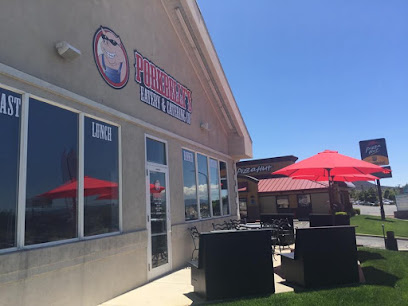
The Majestic Cedar Breaks National Monument: Nature's Amphitheater
Discover Cedar Breaks National Monument in Utah, a natural amphitheater with stunning red rock formations, lush forests, and some of the darkest skies for stargazing.
Cedar Breaks National Monument is a hidden gem in the heart of Utah. This natural amphitheater boasts breathtaking views, with its vibrant red rock formations and lush green forests creating a stunning contrast. At over 10,000 feet above sea level, the monument offers a cool respite from the summer heat and a winter wonderland during the colder months. The unique geology of Cedar Breaks is a result of millions of years of erosion, revealing layers of sedimentary rock that are both beautiful and awe-inspiring. Visitors can enjoy a variety of activities at Cedar Breaks, from scenic drives and hiking trails to stargazing and wildlife watching. The monument is home to a diverse range of flora and fauna, including ancient bristlecone pines and colorful wildflower meadows, which bloom in the summer. The park's elevated location also makes it an ideal spot for stargazing, with some of the darkest skies in the country offering unparalleled views of the Milky Way and other celestial wonders. For those looking to explore the area on foot, there are several hiking trails that cater to different skill levels. The Spectra Point and Ramparts Overlook Trail is a popular choice, offering stunning views of the amphitheater and surrounding landscape. In the winter, visitors can enjoy snowshoeing and cross-country skiing, with the park's snow-covered terrain providing a serene and picturesque setting. Whether you're an avid hiker, a nature lover, or simply looking for a peaceful retreat, Cedar Breaks National Monument is a must-visit destination that promises to leave a lasting impression.
Local tips in Cedar Breaks National Monument
- Bring layers of clothing; temperatures can vary greatly due to the high elevation.
- Visit during late June to early August to see the wildflower meadows in full bloom.
- Check the weather forecast before your visit, as the high elevation can lead to sudden weather changes.
- Plan your visit for a clear night to experience the incredible stargazing opportunities.
- Don't forget sunscreen and a hat, as the sun can be intense at high altitudes.
The Majestic Cedar Breaks National Monument: Nature's Amphitheater
Cedar Breaks National Monument is a hidden gem in the heart of Utah. This natural amphitheater boasts breathtaking views, with its vibrant red rock formations and lush green forests creating a stunning contrast. At over 10,000 feet above sea level, the monument offers a cool respite from the summer heat and a winter wonderland during the colder months. The unique geology of Cedar Breaks is a result of millions of years of erosion, revealing layers of sedimentary rock that are both beautiful and awe-inspiring. Visitors can enjoy a variety of activities at Cedar Breaks, from scenic drives and hiking trails to stargazing and wildlife watching. The monument is home to a diverse range of flora and fauna, including ancient bristlecone pines and colorful wildflower meadows, which bloom in the summer. The park's elevated location also makes it an ideal spot for stargazing, with some of the darkest skies in the country offering unparalleled views of the Milky Way and other celestial wonders. For those looking to explore the area on foot, there are several hiking trails that cater to different skill levels. The Spectra Point and Ramparts Overlook Trail is a popular choice, offering stunning views of the amphitheater and surrounding landscape. In the winter, visitors can enjoy snowshoeing and cross-country skiing, with the park's snow-covered terrain providing a serene and picturesque setting. Whether you're an avid hiker, a nature lover, or simply looking for a peaceful retreat, Cedar Breaks National Monument is a must-visit destination that promises to leave a lasting impression.
When is the best time to go to Cedar Breaks National Monument?
Iconic landmarks you can’t miss
Dixie National Forest
Discover the breathtaking beauty and outdoor adventures at Dixie National Forest, a stunning national forest in Utah with diverse landscapes and wildlife.

Grand Staircase-Escalante National Monument
Explore the breathtaking landscapes of Grand Staircase-Escalante National Monument, a haven for outdoor enthusiasts and nature lovers in Utah.

Parowan Gap Petroglyphs
Discover the ancient artistry of the Parowan Gap Petroglyphs, a captivating historical landmark in Utah that showcases indigenous rock art.

Cedar Breaks National Monument: Visitor Contact Station
Discover Cedar Breaks National Monument Visitor Center, your gateway to stunning rock formations, educational exhibits, and unforgettable outdoor adventures in Utah.

Cedar City Lighthouse
Explore Cedar City Lighthouse, a captivating scenic spot in Utah, perfect for photography and serene nature escapes.

United States Map Landmark
Explore the United States Map Landmark in Parowan, Utah, a unique historical site showcasing the country's geography amidst stunning natural beauty.

Cedar Breaks
Discover the stunning beauty of Cedar Breaks National Monument, a natural amphitheater in Utah known for its vibrant colors and breathtaking hiking trails.

Cedar Breaks National Monument Administrative Office
Explore Cedar Breaks National Monument's breathtaking landscapes, unique geological formations, and vibrant ecosystems in Utah's natural paradise.

Cedar Breaks Amphitheater
Discover Cedar Breaks Amphitheater, a breathtaking natural marvel in Utah, featuring stunning views, vibrant wildflowers, and unique geological formations.

Unmissable attractions to see
Cedar Breaks National Monument: Visitor Contact Station
Discover the stunning beauty of Cedar Breaks National Monument in Utah, featuring breathtaking vistas, vibrant rock formations, and endless outdoor adventures.

Riverside Walk Trailhead
Experience the natural beauty of the Riverside Walk Trailhead in Zion National Park, where stunning landscapes and serene river views await every visitor.

Top of the World
Discover the breathtaking vistas and serene landscapes at Top of the World, a premier tourist attraction in Hurricane, Utah, perfect for nature lovers and adventurers.

Devils Garden
Discover the stunning rock formations and natural landscapes at Devils Garden, a must-visit destination in the heart of Utah's desert beauty.

Cedar Breaks
Explore Cedar Breaks, Utah's breathtaking natural amphitheater, renowned for its stunning colors and outdoor adventures in a serene setting.

Essential places to dine
All American Diner
Experience classic American breakfast at All American Diner in Cedar City – where hearty meals meet friendly service.

Centro Woodfired Pizzeria
Experience authentic wood-fired pizzas and exquisite European dishes at Centro Woodfired Pizzeria in Cedar City.

Lupita's Mexican Restaurant
Discover authentic Mexican cuisine at Lupita's Mexican Restaurant in Cedar City – where every dish is a celebration of flavor.

The Pizza Cart
Discover delicious handcrafted pizzas at The Pizza Cart in Cedar City – where every bite is a taste of culinary delight.

Culver's
Savor delicious American comfort food at Culver's in Cedar City - home of ButterBurgers and creamy frozen custard!

Tacos El Jefe
Discover the vibrant flavors of authentic Mexican cuisine at Tacos El Jefe in Cedar City - perfect for quick bites and satisfying meals.

Wendy's
Savor delicious fast food at Wendy's in Cedar City - home of fresh burgers and friendly service.

Brody's Mexican Restaurant
Discover the flavors of Mexico at Brody's Mexican Restaurant in Cedar City - where every dish tells a story.

IHOP
Experience the comfort of American breakfast classics at IHOP in Cedar City - where families gather and appetites are satisfied.

Sizzler
Discover Sizzler in Cedar City – where delicious meals meet family-friendly service in a vibrant atmosphere.

Chili's Grill & Bar
Experience flavorful American and Tex-Mex cuisine at Chili's Grill & Bar in Cedar City – perfect for families and friends looking to dine out.

Costa Vida
Discover authentic Mexican cuisine at Costa Vida in Cedar City – where fresh ingredients meet bold flavors in every bite.

Chef Alfredo's Ristorante Italiano
Indulge in authentic Italian flavors at Chef Alfredo's Ristorante Italiano – where every meal is a celebration of taste and tradition.

Pork Belly's Eatery & Catering Co.
Discover delightful American cuisine at Pork Belly's Eatery & Catering Co., where every meal feels like home.

The Grind Coffeehouse
Discover Cedar City's local favorite, The Grind Coffeehouse—where great coffee meets delicious breakfast in a cozy atmosphere.

Markets, malls and hidden boutiques
Walmart Supercenter
Explore the expansive selection at Walmart Supercenter in Cedar City, your ultimate destination for groceries, electronics, clothing, and more at affordable prices.

Cedar Breaks National Monument
Experience the breathtaking beauty of Cedar Breaks National Monument, where stunning rock formations and vibrant wildflowers await every nature lover.

Best Western Town & Country Inn
Experience comfort and hospitality at Best Western Town & Country Inn, your gateway to exploring Cedar City and Utah's stunning natural wonders.

Ramada by Wyndham Cedar City
Discover comfort and convenience at Ramada by Wyndham Cedar City, your gateway to Southern Utah's natural beauty and cultural attractions.

La Quinta Inn & Suites by Wyndham Cedar City
Experience comfort and convenience at La Quinta Inn & Suites in Cedar City, the gateway to Utah's natural wonders and cultural gems.

Best Western Plus Cedar City
Experience the perfect blend of comfort and convenience at Best Western Plus Cedar City, your ideal home base for exploring Utah's natural beauty.

Cedar City Towne Center
Explore Cedar City Towne Center, a vibrant shopping mall offering diverse retail and dining options in the heart of Cedar City, Utah.

SpringHill Suites Cedar City
Experience comfort and convenience at SpringHill Suites Cedar City, your gateway to Utah's stunning national parks and vibrant arts scene.

Hampton Inn Cedar City
Discover the perfect blend of comfort and convenience at Hampton Inn Cedar City, your gateway to Utah's stunning landscapes and vibrant culture.

JOANN Fabric and Crafts
Discover a world of creativity at JOANN Fabric and Crafts in Cedar City, where your DIY dreams become reality with endless supplies and inspiration.

Cowboys & Indians
Immerse yourself in the spirit of the American West at Cowboys & Indians gift shop, offering unique treasures and authentic Native American art.

Magnuson Hotel Cedar City
Discover comfort and convenience at Magnuson Hotel Cedar City, your perfect base for exploring Utah's stunning natural beauty and vibrant cultural scene.

Gunjah the Bead Forest
Explore Gunjah the Bead Forest in Cedar City—your creative oasis for beads, games, and crafting inspiration.

Renaissance square
Explore Renaissance Square in Cedar City, a vibrant shopping mall offering diverse stores and delightful dining options for every traveler.

Cedar Band Travel Plaza
Discover Cedar Band Travel Plaza, a vital gas station and convenience store in Cedar City, Utah, offering top-notch services for all travelers.

Essential bars & hidden hideouts
Cedar Breaks National Monument
Explore the stunning amphitheater, vibrant wildflowers, and rugged trails of Cedar Breaks National Monument in beautiful Southern Utah.

Chili's Grill & Bar
Experience the vibrant flavors of American, Tex-Mex, and Mexican cuisine at Chili's Grill & Bar in Cedar City, perfect for families and food lovers alike.

Local Phrases about Cedar Breaks National Monument
-
- HelloShi-yo
[Shee-yo] - GoodbyeNani
[Nah-nee] - YesEe
[Ee] - NoAho
[Ah-ho] - Please/You're welcomeAa'no
[Ah-noh] - Thank youAhe'hee'
[Ah-hay-hee] - Excuse me/SorrySumu
[Soo-moo] - How are you?Aniin
[Ah-neen] - Fine. And you?Hee'ei. Aya
[Hay-ay. Ah-yah] - Do you speak English?Inglish diya?
[Ing-lish dee-yah] - I don't understandAwa'ah
[Ah-wah-ah]
- HelloShi-yo
-
- I'd like to see the menu, pleaseMenu shiyo
[Men-oo shee-yo] - I don't eat meatNa'ahotsoh baa
[Nah-ah-hot-soh bah] - Cheers!Ahe'hee'
[Ah-hay-hee] - I would like to pay, pleaseYaa'shaa
[Yah-shah]
- I'd like to see the menu, pleaseMenu shiyo
-
- Help!Ayoy
[Ah-yoy] - Go away!Atsa'ii
[Aht-sah-ee] - Call the Police!Naal'a
[Nah-lah] - Call a doctor!Bilasana
[Bee-lah-sah-nah] - I'm lostWaa-nah
[Wah-nah] - I'm illYah'at'eh
[Yah-at-eh]
- Help!Ayoy
-
- I'd like to buy...Shiyo
[Shee-yo] - I'm just lookingTsa'ah
[Tsah-ah] - How much is it?Tsii'ei
[Tsee-ee] - That's too expensiveTso t'aa
[Tsoh-tah] - Can you lower the price?T'aa hanaa
[Tah-hah-nah]
- I'd like to buy...Shiyo
-
- What time is it?Tsosts'id
[Tsoh-tseet] - It's one o'clockT'aalii
[Tah-lee] - Half past (10)Naakaii
[Nah-kah-ee] - MorningAheeh
[Ah-hay-hee] - AfternoonAnii
[Ah-neee] - EveningT'aa'ee
[Tah-ee] - YesterdayAak'ee
[Aah-kee] - TodayK'aal
[Kah-al] - TomorrowT'aa'ii
[Tah-ee] - 1Tsin
[Tseen] - 2Naaki
[Nah-kee] - 3Taas
[Tah-s] - 4Diné
[Dee-nay] - 5Ashdla'
[Ash-dlah] - 6Hastó
[Has-toh] - 7Tseebíí
[Tsee-bee-ee] - 8Tsinil
[Tsee-neel] - 9T'áá
[Tah-ah] - 10Ndaa
[Nah-dah]
- What time is it?Tsosts'id
-
- Where's a/the...?Haaʼdééʼ
[Hah-deh-eh] - What's the address?Béésh łitso
[Bay-sh leet-soh] - Can you show me (on the map)?Naalnish
[Nah-lneesh] - When's the next (bus)?Haaʼátʼíísh
[Hah-ah-tih-ish] - A ticket (to ....)Naʼnitin
[Nah-nee-teen]
- Where's a/the...?Haaʼdééʼ
History of Cedar Breaks National Monument
-
Long before European settlers arrived, the area now known as Cedar Breaks National Monument was inhabited by Native American tribes, primarily the Southern Paiute. These tribes referred to the area as 'u-map-wich,' meaning 'Mountain Ridge that is difficult to cross.' They used the land for seasonal hunting and gathering, leaving behind petroglyphs and other artifacts that provide a glimpse into their rich cultural history.
-
The first recorded European exploration of the Cedar Breaks area was by the Dominguez-Escalante expedition in 1776. While their main objective was to find a route to California, they documented the region's unique geological formations and the challenging terrain. Their journals provided some of the earliest European descriptions of the area.
-
In the mid-19th century, Mormon settlers began to explore and settle in Utah. Brigham Young, the leader of the Mormon Church, sent settlers to the area around Cedar Breaks to establish communities. These settlers were among the first to refer to the area as 'Breaks,' a term used in the West to describe abrupt changes in topography. They utilized the land for timber, grazing, and other agricultural activities.
-
Cedar Breaks National Monument was officially established on August 22, 1933, by President Franklin D. Roosevelt. The designation was part of a broader New Deal effort to promote conservation and provide public works jobs during the Great Depression. The Civilian Conservation Corps (CCC) played a crucial role in the development of the monument's infrastructure, building trails, roads, and visitor facilities that are still in use today.
-
Cedar Breaks is renowned for its stunning geological formations, including its amphitheater, which spans over three miles and plunges more than 2,000 feet deep. The area showcases layers of limestone, shale, and sandstone that have been sculpted by millions of years of erosion. These formations provide a vivid record of the Earth's geological history, attracting scientists and geologists from around the world.
-
The monument is home to a diverse range of flora and fauna. Its high-altitude environment supports subalpine meadows that burst into bloom with wildflowers during the summer months. The area is also a habitat for numerous species of birds, mammals, and insects, making it a vital ecological zone. Efforts to preserve this biodiversity have been a key focus of the monument's management.
-
Cedar Breaks National Monument is recognized as an excellent location for stargazing due to its high elevation and low levels of light pollution. In 2017, it was designated as an International Dark Sky Park. This recognition underscores the monument's commitment to preserving its pristine night skies, allowing visitors to experience the wonders of the cosmos in a way that is increasingly rare in the modern world.
Cedar Breaks National Monument Essentials
-
Cedar Breaks National Monument is located in southwestern Utah. The nearest major airport is McCarran International Airport in Las Vegas, Nevada, approximately 180 miles away. Alternatively, you can fly into Salt Lake City International Airport, which is about 250 miles to the north. From these airports, you can rent a car and drive to the monument. The most common route is via Interstate 15, then taking exit 59 at Cedar City and following UT-14 east to UT-148 south, which leads directly to Cedar Breaks.
-
Having a car is essential for exploring Cedar Breaks National Monument and the surrounding areas. There is no public transportation to the monument, and the nearest town, Cedar City, is about 25 miles away. Car rentals are available at major airports and in Cedar City. During the winter months, certain roads may be closed due to snow, so it's advisable to check road conditions and have a vehicle equipped for winter driving.
-
The official currency is the United States Dollar (USD). Credit cards are widely accepted at restaurants, hotels, and shops in nearby towns like Cedar City. However, it's a good idea to carry some cash for entrance fees, smaller purchases, or in case you visit rural areas where card payment may not be an option. ATMs are available in Cedar City, but there are no ATM facilities within the monument itself.
-
Cedar Breaks National Monument is generally very safe for tourists. However, visitors should be cautious when hiking or exploring remote areas, as the terrain can be rugged and weather conditions can change rapidly. There are no areas with high crime rates targeting tourists within the monument. Standard precautions like keeping an eye on your belongings and not wandering alone at night in remote areas are advisable. Wildlife encounters are possible, so maintain a safe distance from animals.
-
In case of an emergency, dial 911 for immediate assistance. There is limited cell phone coverage within the monument, so it is essential to inform someone of your plans and estimated return time. The nearest medical facilities are located in Cedar City, about 25 miles away. For minor injuries, the visitor center offers basic first aid supplies. It is recommended to carry a first aid kit and have travel insurance that covers medical emergencies.
-
Fashion: Do dress in layers, as weather can change quickly. Wear sturdy hiking boots and bring sun protection. Avoid wearing flip-flops or open-toed shoes on trails. Religion: Do show respect for any cultural or historical sites within the monument. Public Transport: As there is no public transport, do plan for car travel. Greetings: A friendly wave or nod is common among hikers and visitors. Eating & Drinking: Do pack out all trash and food waste. Don't feed wildlife, as it disrupts their natural habits and can be dangerous.
-
To experience Cedar Breaks National Monument like a local, consider visiting during the shoulder seasons (late spring and early fall) when the weather is mild and the crowds are smaller. Attend ranger-led programs for insightful information about the area's geology and history. Stargazing is a must, as Cedar Breaks is designated as an International Dark Sky Park, offering some of the best night sky views in the region. Also, try to visit nearby attractions such as Bryce Canyon and Zion National Park to round out your trip.
Trending Landmarks in Cedar Breaks National Monument
Nearby Cities to Cedar Breaks National Monument
-
Things To Do in Panguitch
-
Things To Do in Mt Carmel
-
Things To Do in Springdale
-
Things To Do in Bryce Canyon City
-
Things To Do in Kanab
-
Things To Do in Beaver
-
Things To Do in St. George
-
Things To Do in Escalante
-
Things To Do in Mesquite
-
Things To Do in Richfield
-
Things To Do in Torrey
-
Things To Do in Page
-
Things To Do in Grand Canyon Village
-
Things To Do in Delta
-
Things To Do in Ephraim









